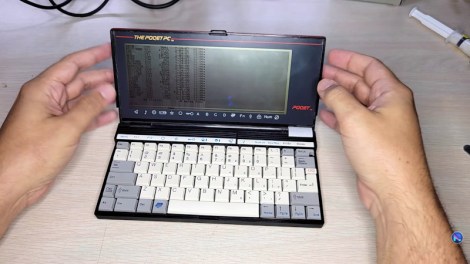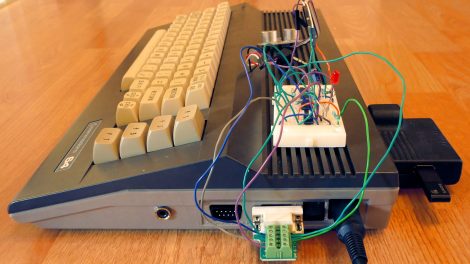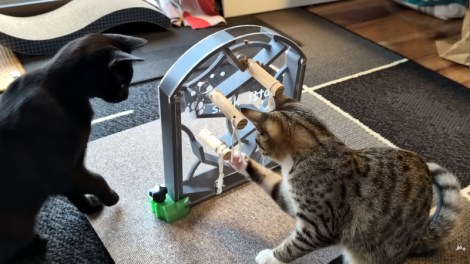

__ __ __ ___ / // /__ _____/ /__ ___ _ / _ \___ ___ __ / _ / _ `/ __/ '_/ / _ `/ / // / _ `/ // / /_//_/\_,_/\__/_/\_\ \_,_/ /____/\_,_/\_, / retro edition /___/Now optimized for embedded devices!!
| About | Successes | Retrocomputing guide | Email Hackaday |

It sometimes seems as though computing power in your pocket is a relatively new phenomenon, but in fact there have been ultraportable computers since the 8-bit era. They started to become useful around the end of the 1980s though as enterprising manufacturers started cramming full-fat PC XTs into pocket form factors. Of these the one to own was the Poqet PC, a slim clamshell design that would run for ages on a pair of AA cells . If you have one today you’d be lucky if its display ribbon cable is without faults though, and [Robert’s Retro] is here with a fix previously thought impossible.
A large proportion of the video below the break is devoted to dismantling the unit, no easy task. The cable once exposed is found to have delaminated completely, and he takes us through the delicate task of attaching a modern equivalent. We particularly like the way in which the cable’s own springiness is used to retract it. The result has a white cable rather than the original black, but that’s a small price to pay for a machine that works rather than a broken paperweight.
If early pocket computing is your thing, it’s a subject we’ve covered before.

Artificial Neural Networks (ANNs) are commonly used for machine vision purposes, where they are tasked with object recognition. This is accomplished by taking a multi-layer network and using a training data set to configure the weights associated with each ‘neuron’. Due to the complexity of these ANNs for non-trivial data sets, it’s often hard to make head or tails of what the network is actually matching in a given (non-training data) input. In a March 2024 study (preprint) by [A. Radhakrishnan] and colleagues in Science an approach is provided to elucidate and diagnose this mystery somewhat, by using what they call the average gradient outer product (AGOP).
Defined as the uncentered covariance matrix of the ANN’s input-output gradients averaged over the training dataset, this property can provide information on the data set’s features used for predictions. This turns out to be strongly correlated with repetitive information, such as the presence of eyes in recognizing whether lipstick is being worn and star patterns in a car and truck data set rather than anything to do with the (highly variable) vehicles. None of this was perhaps too surprising, but a number of the same researchers used the same AGOP for elucidating the mechanism behind neural collapse (NC) in ANNs.
NC occurs when an ANN gets overtrained (overparametrized). In the preprint paper by [D. Beaglehole] et al. the AGOP is used to provide evidence for the mechanism behind NC during feature learning. Perhaps the biggest take-away from these papers is that while ANNs can be useful, they’re also incredibly complex and poorly understood. The more we learn about their properties, the more appropriately we can use them.

An object of desire back in the mid-1990s might have been Apple’s QuickTake camera. In a form factor not unlike a monocular it packed a 640×480 digital camera, the images from which could be downloaded to a computer via a serial cable. A quarter century later it’s a great retro camera for the enthusiast, but both the serial ports and the operating systems needed to run its software have passed into history. Time for the junk pile? Not at all, for [Crazylegstoo] has produced a new piece of software for 2024 that works for both QuickTake 100 and 150 cameras with USB serial ports on modern operating systems.
Called JQuickTake, it’s a Java app which has the advantage of building on that early Java promise of running cross platform so can be had for Mac or Windows. It allows retrieval of both metadata and images from the camera, but sadly it doesn’t display any of the images. It also doesn’t work with the QuickTake 200. Happily though, there are instructions for building a serial cable, and suggestions for how to deal with the proprietary QTK image format.
Meanwhile if you lack a PC or Mac all is not lost. You can also use these cameras with an Apple II.
Header image: Hannes Grobe, CC BY-SA 4.0.

Most electromagnetic actuators are rotating motors, or some variation on the theme, like servos. However, it’s possible to do linear actuation with electomagnetics, too. [Adrian Perez] demonstrates this with Linette, his design of a linear actuator that he was inspired to build by the structure of our own muscles.
The design uses a coil of copper wire in a 3D-printed plastic housing, surrounded by a claw full of strong magnets. When the coil is activated, the magnets are pulled towards the coil. When the coil is not energized, the magnets fall away. [Adrian] demonstrates the actuator under the control of an Arduino, which switches power to the coil to move it up and down.
He also notes that the design is similar solenoids and voice coil style actuators, though unlike most his uses discrete magnets rather than a single monolithic magnet. It’s possible to get more capacity out of the Linette design through stacking. You can parallelize the actuators to get more pulling force, with neighboring coils sharing the same magnets. Alternatively, you can stack them in series to get longer stroke lengths.
[Adrian] hasn’t put the design to a practical application yet, but we could see multiple uses for robotics or small machines. We’ve seen some other neat DIY magnetic actuators before, too. Video after the break.


Between World War II and Y2K, shortwave listening was quite an education. With a simple receiver, you could listen to the world. Some of it, of course, was entertainment, and much of it was propaganda of one sort or another. But you could learn a lot. Kids with shortwave radios always did great in geography. Getting the news from a different perspective is often illuminating, too. Learning about other cultures and people in such a direct way is priceless. Getting a QSL card in the mail from a faraway land seemed very exciting back then.
Today, the shortwave landscape is a mere shadow of itself. According to a Wikipedia page, there are 235 active shortwave broadcasters from a list of 414, so nearly half are defunct. Not only are there many “dead” shortwave outlets, but many of the ones that are left are either not aimed at the world market or serve a niche group of listeners.
You can argue that with the Internet, you don’t need radio, and that’s probably correct in some ways but misses a few important points. Indeed, many broadcasters still exist as streaming stations or a mix of radio and streaming. I have to admit I listen to the BBC often but rarely on the air. My computer or phone plays it in crystal clarity 24 hours a day.

So, while a 14-year-old in 1975 might be hunched over a radio wearing headphones, straining to hear NHK World Radio, these days, they are likely surfing the popular social media site of the week. You could easily argue that content on YouTube, Instagram, and the like can come from all over the world, so what’s the problem?
The problem is information overload. Faced with a shortwave radio, there were a limited number of options available. What’s more, only a small part of the band might be “open” at any given time. It isn’t like the radio could play games or — unless you were a ham — allow you to chat with your friends. So you found radio stations from Germany to South Africa. From China and Russia, to Canada and Mexico. You knew the capital of Albania. You learned a little Dutch from Radio Nederlands.

This week on the Podcast, it’s Kristina’s turn to bloviate alongside Editor-in-Chief Elliot Williams. First up in the news: our fresh new contest has drawn three entries already! That’s right, the 2024 Tiny Games Challenge is underway. You have until September 10th to show us your best tiny game, whether that means tiny hardware, tiny code, or a tiny BOM.
Then it’s on to What’s That Sound, which sounded familiar to Kristina, but she couldn’t place it. Can you get it? Can you figure it out? Can you guess what’s making that sound? If you can, and your number comes up, you get a special Hackaday Podcast t-shirt.
Then it’s on to the hacks, beginning with a hack to print metal and a way to weld wood, along with a photo-resistor-based, single-pixel camera. We’ll talk desiccants carbon fiber, and Baron Harkonnen. Finally, we discuss the troubles of keeping hygroscopic materials from degrading, and have a klatch about Keebin’ with Kristina.
Check out the links below if you want to follow along, and as always, tell us what you think about this episode in the comments!
Download and savor at your leisure.

These days, most of our microcontroller boards come with bootloaders so you can squirt hex into them straight over USB. However, you don’t need to do things this way. If you’re more old school, you can program your AVRs right from a Commodore 64. [Linus Akesson] shows us how.
Programming an AVR isn’t that hard. By holding the chip in reset, it’s possible to flash code via a serial protocol using just three wires. However, that’s pretty impractical to do with modern PCs — they don’t come with addressable IO pins anymore. Normally, you’d use a dedicated programmer to do the job, but [Linus] found his had died on a Friday night. So he set about turning his C64 into one instead.
He decided to use the pins of the C64’s Joystick Port 2, with pins 1, 2, 3, and 4 hooked up to SCK, MOSI, Reset, and MISO on the AVR, respectively. 5 V and Ground were also provided courtesy of the C64’s port. He then whipped up a simple bit of assembly code to read a bit of AVR hex and spit it out over the Joystick port following the in-circuit programming protocol. With a 1541 Ultimate to load files on to the C64 in hand, it was easy to pull his compiled AVR program off his modern PC, chuck it on the C64, and then get the old Commodore to program the AVR in turn.
It’s not the first time [Linus] has wowed us with a C64 in hand. If you’ve got your own fresh projects for the best-selling computer of all time, don’t hesitate to let us know!

First up this week is the story of EvilVideo, a clever telegram exploit that disguises an APK as a video file. The earliest record we have of this exploit is on June 6th when it was advertised on a hacking forum.
Researchers at ESET discovered a demo of the exploit, and were able to disclose it to Telegram on June 26th. It was finally patched on July 11. While it was advertised as a “one-click” exploit, that’s being a bit generous, as the ESET demo video shows. But it was a clever exploit. The central trick is that an APK file can be sent in a Telegram chat, and it displays what looks like a video preview. Tap the “video” file to watch it, and Telegram prompts you to play it with an external player. But it turns out the external player in this case is Android itself, which prompts the target to install the APK. Sneaky.

The original Nintendo Wii was not a big console, per se, but you could never hope to fit one in your pocket. Or…could you? As it turns out, console modders [Wesk] and [Yveltal] reckon they have found a way to make a functional Wii at the keychain scale!
The concept is called the Kawaii, and as you might expect, some sacrifices are necessary to get it down to pocketable size of 60 x 60 x 16 mm. It’s all based around the “Omega Trim,” an established technique in the modding community to cut a standard Wii motherboard down to size. Controllers are hooked up via a dock connection that also provides video out. There’s no Bluetooth, so Wiimote use is out of the question. You can still play some Wii games with GameCube Controllers by using GC2Wiimote, though. The Wii hardware is under-volted to allow for passive cooling, too, with an aluminum enclosure used to shed heat. Custom PCBs are used to handle power and breakouts, which will be open sourced in due time.
The forum post featured an expression of interest for those eager to order aluminium enclosures to pursue their own Kawaii build. Slots quickly filled up and the EOI was soon closed.
As of now, the Kawaii is still mostly conceptual, with images being very compelling renders. However, it relies on established Wii modding techniques, so there shouldn’t be any shocking surprises in the next stage of development. Expect to see finished Kawaii builds in gorgeous machined aluminum housings before long.
We’ve seen some other great Wii portables over the years. The console remains cheap on the used market and was built in great numbers. Thus, it remains the perfect platform for those eager to get their feet wet in the console modding community!

Cats, to those of us who appreciate their company, are fascinating creatures, with their infinite curiosity and playfulness. [Makers Muse] has a pair of half-grown-up kittens, and set out to provide them with a plaything far better than those the market could offer. The result is the Snak Attak, a gravity puzzle maze that delivers kibble for the cat prepared to puzzle it out.
The point of this exercise isn’t to give kibble but to provide the optimum play experience for a pair of younger cats. The premise is that kibble is held back by a set of wooden pegs each with a temptingly dangly string, and they should after some investigation be able to pull the pegs out and release it. What’s interesting is how the two different cats approach the problem, while one pulls the out as expected, the other pushes them from the back of the device.
The conclusion is that the two cats can indeed solve puzzles, and gain hours of play from the device. An updated version was produced with a few more challenges, and as you can see in the video below the break, it’s captivated their attention. It’s not the first cat toy we’ve brought you by any means, this robotic mouse springs to mind, but it’s certainly upped the ante on feline entertainment.